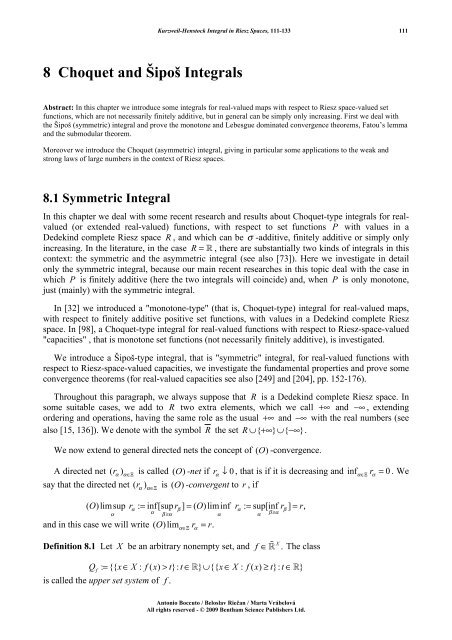Kurzweil-Henstock Integral in Riesz spaces - Bentham Science
Kurzweil-Henstock Integral in Riesz spaces - Bentham Science
Kurzweil-Henstock Integral in Riesz spaces - Bentham Science
You also want an ePaper? Increase the reach of your titles
YUMPU automatically turns print PDFs into web optimized ePapers that Google loves.
8 Choquet and ipo <strong>Integral</strong>s<br />
<strong>Kurzweil</strong>-<strong>Henstock</strong> <strong>Integral</strong> <strong>in</strong> <strong>Riesz</strong> Spaces, 111-133 111<br />
Abstract: In this chapter we <strong>in</strong>troduce some <strong>in</strong>tegrals for real-valued maps with respect to <strong>Riesz</strong> space-valued set<br />
functions, which are not necessarily f<strong>in</strong>itely additive, but <strong>in</strong> general can be simply only <strong>in</strong>creas<strong>in</strong>g. First we deal with<br />
the ipo (symmetric) <strong>in</strong>tegral and prove the monotone and Lebesgue dom<strong>in</strong>ated convergence theorems, Fatou’s lemma<br />
and the submodular theorem.<br />
Moreover we <strong>in</strong>troduce the Choquet (asymmetric) <strong>in</strong>tegral, giv<strong>in</strong>g <strong>in</strong> particular some applications to the weak and<br />
strong laws of large numbers <strong>in</strong> the context of <strong>Riesz</strong> <strong>spaces</strong>.<br />
<br />
8.1 Symmetric <strong>Integral</strong><br />
In this chapter we deal with some recent research and results about Choquet-type <strong>in</strong>tegrals for realvalued<br />
(or extended real-valued) functions, with respect to set functions with values <strong>in</strong> a<br />
Dedek<strong>in</strong>d complete <strong>Riesz</strong> space , and which can be -additive, f<strong>in</strong>itely additive or simply only<br />
<strong>in</strong>creas<strong>in</strong>g. In the literature, <strong>in</strong> the case , there are substantially two k<strong>in</strong>ds of <strong>in</strong>tegrals <strong>in</strong> this<br />
context: the symmetric and the asymmetric <strong>in</strong>tegral (see also [73]). Here we <strong>in</strong>vestigate <strong>in</strong> detail<br />
only the symmetric <strong>in</strong>tegral, because our ma<strong>in</strong> recent researches <strong>in</strong> this topic deal with the case <strong>in</strong><br />
which is f<strong>in</strong>itely additive (here the two <strong>in</strong>tegrals will co<strong>in</strong>cide) and, when is only monotone,<br />
just (ma<strong>in</strong>ly) with the symmetric <strong>in</strong>tegral.<br />
In [32] we <strong>in</strong>troduced a "monotone-type" (that is, Choquet-type) <strong>in</strong>tegral for real-valued maps,<br />
with respect to f<strong>in</strong>itely additive positive set functions, with values <strong>in</strong> a Dedek<strong>in</strong>d complete <strong>Riesz</strong><br />
space. In [98], a Choquet-type <strong>in</strong>tegral for real-valued functions with respect to <strong>Riesz</strong>-space-valued<br />
"capacities" , that is monotone set functions (not necessarily f<strong>in</strong>itely additive), is <strong>in</strong>vestigated.<br />
We <strong>in</strong>troduce a ipo-type <strong>in</strong>tegral, that is "symmetric" <strong>in</strong>tegral, for real-valued functions with<br />
respect to <strong>Riesz</strong>-space-valued capacities, we <strong>in</strong>vestigate the fundamental properties and prove some<br />
convergence theorems (for real-valued capacities see also [249] and [204], pp. 152-176).<br />
Throughout this paragraph, we always suppose that is a Dedek<strong>in</strong>d complete <strong>Riesz</strong> space. In<br />
some suitable cases, we add to two extra elements, which we call and , extend<strong>in</strong>g<br />
order<strong>in</strong>g and operations, hav<strong>in</strong>g the same role as the usual and with the real numbers (see<br />
also [15, 136]). We denote with the symbol the set .<br />
We now extend to general directed nets the concept of -convergence.<br />
A directed net is called -net if , that is if it is decreas<strong>in</strong>g and . We<br />
say that the directed net is -convergent to , if<br />
and <strong>in</strong> this case we will write<br />
Def<strong>in</strong>ition 8.1 Let be an arbitrary nonempty set, and The class<br />
is called the upper set system of<br />
Antonio Boccuto / Beloslav Riean / Marta Vrábelová<br />
All rights reserved - © 2009 <strong>Bentham</strong> <strong>Science</strong> Publishers Ltd.

















